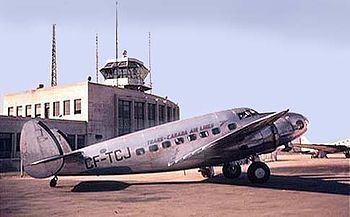Summary In-flight fire Survivors 0 Date 13 January 1939 Survivor 0 Crew count 2 | Passengers 2 Registration NC17389 Fatalities 4 (all) Passenger count 2 | |
 | ||
Aircraft type Lockheed 14H Super Electra | ||
Northwest Airlines Flight 1, registration NC17389, was a Lockheed 14H Super Electra aircraft which crashed approximately ½ mile southwest of the Miles City, Montana, airport on January 13, 1939. All four on board were killed in the accident.
Flight 1 normally originated in Chicago, Illinois, and ended in Seattle, Washington, via the intermediate stops Minneapolis, Minnesota; Fargo, North Dakota; Bismarck, North Dakota; Miles City, Montana; Billings, Montana; Butte, Montana; and Spokane, Washington. On the date of the accident, the flight actually began in Minneapolis and departed at 4:00 PM local time.
The flight reached Miles City, Montana, at 7:41 PM Mountain time to refuel and take on cargo. Takeoff from Miles City Municipal Airport was delayed for over an hour due to weather conditions at Billings, but the aircraft eventually departed at 9:14 PM with only two passengers on board. Shortly after takeoff, and at an altitude of five hundred feet above ground level (AGL), the aircraft began a short turn to the left, lost altitude rapidly, and descended almost to the ground. It then pulled up into a sharp climb, reached about 500 feet AGL again, turned left again and descended rapidly into a ravine approximately ½ mile southwest of the field.
Investigators with the United States Department of Commerce's Civil Aeronautics Authority (CAA), a predecessor organization to both the FAA and the NTSB, determined that an intense fire had developed in the cockpit shortly after the aircraft had departed the airport. Although the state of the wreckage prevented investigators from definitively pinpointing the exact origin of the fire, an area of severe burning was found close to the cross-feed fuel valve located in the cockpit between the pilot and co-pilot. The Super Electra's cross-feed fuel system maintained a constant pressure of approximately 4½ pounds, and there had been numerous reports of leakage in the vicinity of the valve. Lockheed designers had not provided any method by which any fuel that did leak from the valve could safely be drained. It was also difficult to maintain or inspect the valve due to its location.
The CAA recommended that the cross-feed fuel system be relocated to allow for easier maintenance and inspection and to reduce the possibility of a cockpit fire caused by fuel leakage. They also recommended that areas of leakage in the fuel line be modified so as to allow for adequate drainage.
This accident occurred almost exactly one year after Northwest Airlines Flight 2 crashed near Bozeman, Montana. These accidents, as well as two others which befell Northwest Airlines Super Electras in 1938, called into question the airworthiness and commercial potential of the model. Northwest Airlines sold off its fleet of Electras soon after this accident.
This flight number was used for many years on Northwest Airlines' Los Angeles-Tokyo-Ho Chi Minh City route. But after Northwest Airlines was acquired by Delta, the "Northwest Flight 1" designation no longer existed.
